Should sorry be the hardest word?
22nd March 2019 | Professor Nick Lee, Tim Riesterer and Doug Hutton
New research reveals a formula for communicating an apology that generates greater customer satisfaction and loyalty after a service failure.
In recent issues of this Journal, we’ve published three pieces of original research on improving messaging for critical customer success situations: renewals, price increases and upgrades. In each case we provided a tested, proven framework for the most effective approach to each of these commercial scenarios.
As usually happens, we were then approached with another question or concern that sales and customer success leaders wanted studied. In this case, they said: “These are all interesting studies, but what do you do if your customer has a bad experience with you?”
Which led us to our fourth customer success messaging test – this time focused on apologies. In this article, you will learn the most effective way to organize and communicate an apology when your customers experience a product or service failure with your solution.
Service recovery paradox
Have you ever had a service problem with a customer and worried about the negative impact it would have on your relationship and long-term revenue prospects? Maybe they won’t renew. Maybe they won’t buy more. And, worse, maybe they will spread the word throughout their network and negatively impact other prospect or customer decisions.
On the flipside, has it ever happened where you put a recovery plan in place and you were able to improve customer loyalty after the failure? Perhaps at even higher levels of satisfaction than before you had the issue?
If this has ever happened to you or your company, you have entered the service recovery paradox (SRP): the situation in which a customer thinks more highly of you after you have corrected a problem than if they had never had a faulty experience with you (Figure 1).
Most companies spend a lot of time and effort to avoid problems and provide non-faulty service to ensure customer satisfaction and loyalty. But, it turns out it is possible to get an even better outcome if you handle a failure properly. In other words, the inevitable customer crisis can become one of your best opportunities to build greater levels of customer commitment.
This article will look at the existing research around what it takes to evoke this so-called service recovery paradox, which includes the importance of formal apologies. Then, we’ll take it one step further and provide you with the results of a new, original research study on the optimal framework for your apology messaging.
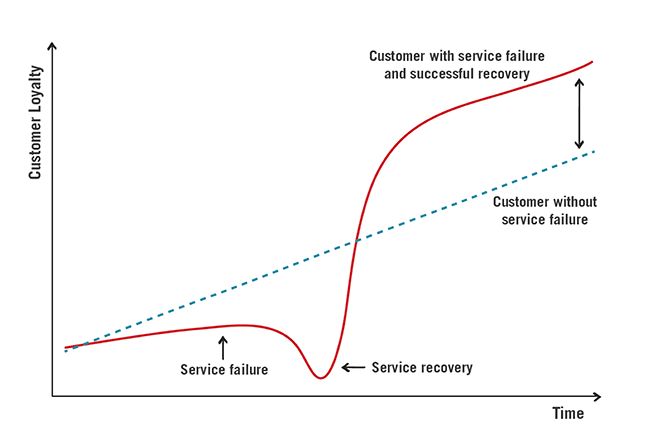
Figure 1: The service recovery paradox.
At the end of this article, you will have a tested, proven messaging tool for improving engagement with your customers when they experience a problem with your solution. An approach that will increase your odds of experiencing the service recovery paradox.
Service recovery paradox in B2B
The service recovery paradox has been well documented in consumer settings, but only recently was this phenomenon validated for the B2B environment. A study appearing in the February 2018 edition of the Journal of Business & Industrial Marketing was the first to prove its existence, and provide a preliminary model for achieving the SRP with business customers (“The service recovery paradox in B2B Relationships,” Hübner, et al).
According to the research, the recovery model for inspiring SRP contains four components:
- Initiation – Speaks to the willingness to engage in recovery actions even if the problem isn’t caused by the failing provider directly, rather a sub-contractor or other third party. Your customer believes you hold full responsibility and expects you to resolve it with professional rigor regardless of who is to blame.
- Response Speed – Relates to the timeliness and responsiveness of recovery actions, especially when service failures affect companies where every second of downtime costs big money. Taking immediate recovery measures once a problem is detected – or even anticipated – increases your chances of recovering from a problem compared with those who do not.
- Compensation – Refers to the allocation of financial and physical resources by the failing provider. For B2B customers the most appreciated compensation comes in the form of additional free-of-charge resources to resolve the service failure as fast as possible. Delayed financial compensation doesn’t make up for their losses, especially losses in internal and external trust.
- Apology – Describes how service providers convey remorse to the affected customer parties in a way that positively influences the perception of the service recovery episode: the propensity of a service failure to result in an SRP increase when you communicate your efforts to eliminate the root cause of service failures and convince the customer it won’t happen again.
Focusing on the apology
Three of the four components described above (Initiation, Response Speed and Compensation) are no doubt vital to achieving SRP. They must take place to get a customer back up and running, while minimizing calculable damage.
But, unless those three recovery activities are well documented and communicated effectively in the right apology framework, you reduce the possibility that everyone inside your affected customer will appreciate and give you credit for your efforts, thereby hampering your ability to raise customer satisfaction and boost customer loyalty above pre- or non-failure levels.
Apologies have been a reasonably well-studied area. For purposes of our research, we focused on foundational findings in the paper “An Exploration of the Structure of Effective Apologies,” (International Association of Conflict Management Research, Lewicki et al, 2016).
Their research identified and demonstrated five individual elements that contribute to an effective apology:
- Acknowledgement of responsibility – a statement which demonstrates you understand your part in the service failure
- Offer of repair – a statement extending a way you plan to fix the problem and work toward rebuilding trust with your customer
- Explanation of the problem – a statement in which the reasons for the failure are explained to the customer
- Expression of regret – a statement in which you, the violator, expresses how sorry you are for the problem
- Declaration of repentance – a statement in which you express a promise to not repeat the problem
Missing research: what’s the best order to express an apology?
While each of these five elements were proven to contribute individually to an effective apology, in our opinion there was one missing, important study still to be done. In reviewing the existing apology science literature, we found no research to determine if there is a best order for these elements. Not only that, the literature studied only general “effectiveness” of apologies, with no specifics of the apology’s impact on tangible sales and customer success outcomes. In other words, there is no official “I’m sorry” apology messaging framework that can be proven to have greater impact on SRP-related questions.
So, we created a test scenario (see Sidebars 1 and 2) and recruited 500 people across North America and Europe to imagine themselves in a service-failure situation, and then measure their responses to important questions related to SRP. We asked them to imagine they were the manager in charge of an HR Benefits Enrolment system that failed during the most critical time of the year – benefits enrolment. And, we told them that the problem had a significant and wide-ranging negative impact on others in the organization, including the senior-most executives.
Sidebar 1: Service failure scenario – your software application goes down at the worst possible time
For the purposes of this study, we asked the participants to imagine that they were responsible for their company’s HR benefits programme. Then, we told them about the following service failure:
“Near the end of the benefits sign-up period, the software your employees use to sign up for benefits goes down for an extended period. Employees are emailing you directly with questions and frustrations, especially with the deadline looming. They are also submitting requests for support to IT, which cannot rectify the problem because it is an issue with the software supplier itself.
“Your HR leadership team and other managers are repeatedly asking you for updates regarding when the problem will be corrected. The software ultimately comes back online, and the sign-up period ends. But, this results in a much higher workload for you and your team to ensure all employees have the necessary benefits. You’re also fielding numerous questions and concerns from company leaders worried about the impact this experience will have on employee satisfaction.”
The participants were then asked a key question: “How would this incident impact your perception of the supplier?” (1-9 scale with 1 = most negative). Existing research demonstrates that SRP kicks in only when the underlying service failure exceeds what Hubner et al. call the “zone of indifference.” In other words, SRP isn’t about the small day-to-day missteps and token apologies that litter a supplier-customer relationship. To truly test apology effectiveness, we needed to ensure that study participants felt particularly acute pain, with the proposed scenario severe enough to impact a wide range of potential customer stakeholders.
Next, the participants were randomly assigned to one of the five apology messaging conditions, and were told:
“You are about to meet with the software supplier for the first time since this serious incident put your department in such a difficult position. What follows will be the written text of their response to the situation.”
Then, they read the apology as text and were asked a series of questions. The responses from the most angry and frustrated participants (those who initially rated their perception of the supplier the lowest) were used to compare the impact of the various apology approaches. The objective was to determine which message could improve the reactions of the “saltiest” customers and provide a clear winning formula for you to follow when you encounter a customer problem.
After reading the description of the service failure, we asked everyone to rank the intensity of their negative feelings toward the supplier in the story. The question read: “How would this incident impact your perception of your supplier?” (Scale of 1-9 where 1 = the most extreme negative perception)
We then took only the most extremely negative respondents (those who rated their perceptions after the service problem as 1 or 2) to see how they reacted to the various apology messages. The goal was to determine the apology framework that had the most positive impact on the most angry and frustrated “customers”, figuring this would be the ultimate test for any “I’m sorry” message framework.
In Figure 2, you’ll see we drafted a sentence or two for each apology component. We then created multiple test conditions by re-ordering how the components appeared and were communicated to the customer, each defensible based on how effective any one apology component was proven to be in the existing research.
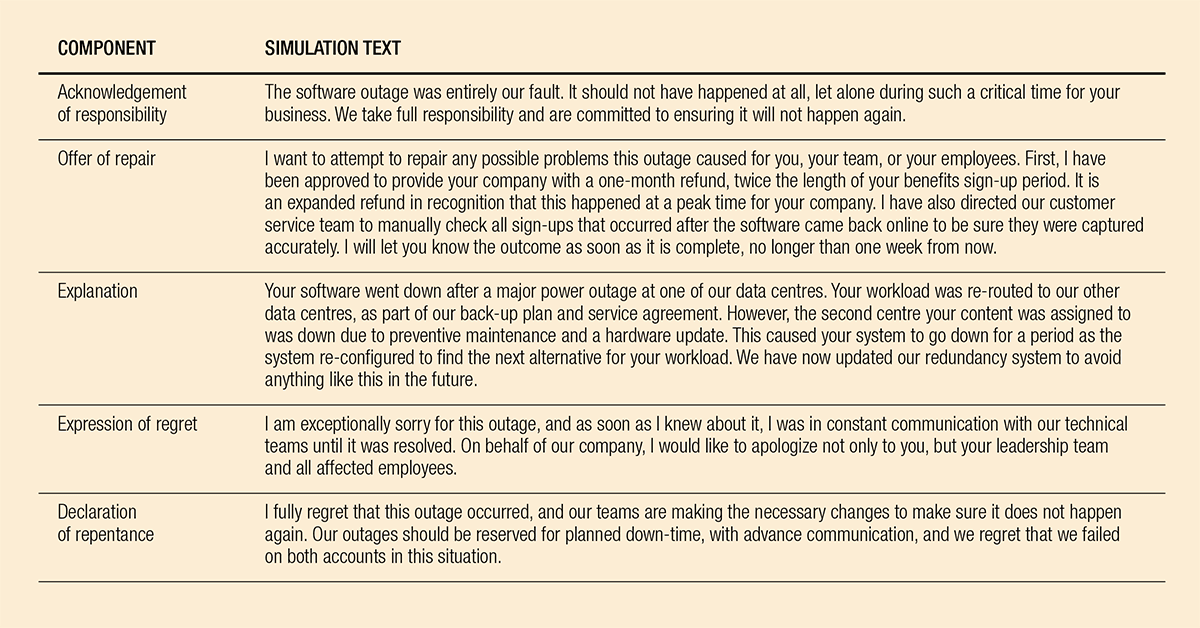
Figure 2: Text for apology components.
Four different combinations of the five elements were created to test for the best approach. A fifth test condition only used two of the five elements to create a control (Figure 3). Specifically, we used just the two most factual apology components and eliminated the more emotional elements. Oftentimes, people in B2B environments argue that emotional content only works in B2C and that just the facts matter in conversations with B2B customers. So, we attempted to see how a factual account of the problem and description of the remedy would compare to the emotionally laden test messages.
At first glance, you might not think that such subtle configuration changes, using elements already proven to be individually effective in previous apology science studies, would produce a single, consistent winning framework.
On the contrary, we discovered one of these approaches did outperform all the others, across every question asked. (Remember that we were looking specifically at the responses of the most infuriated customer.) The one clear and consistent winner was test Condition #3 (Figure 4). While, the emotionless, just-the-facts approach consistently landed at or near the bottom on every question.
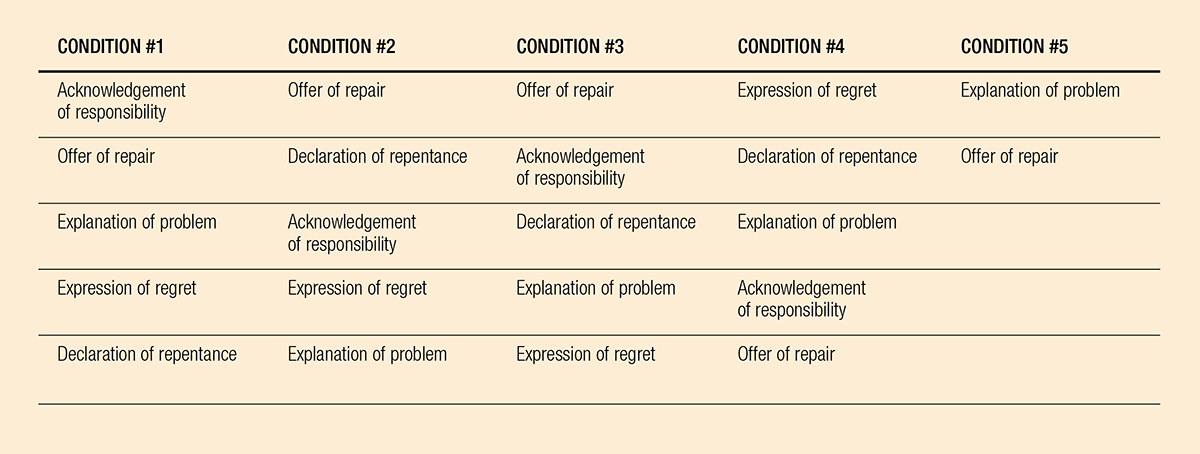
Figure 3: The different apology combination test conditions.
Service recovery paradox-related results
Looking at the questions best-related to the service recovery paradox, you will see this winning approach measurably improves your ability to increase customer satisfaction and loyalty even after a service failure. We didn’t ask the question of satisfaction or loyalty directly, but instead asked behavioural outcome-type questions related to willingness to continue buying or buy more from the supplier. We also asked questions related to advocacy and willingness to recommend or serve as a reference for the supplier. All this was asked after “experiencing” the failure and reading the apology (Figures 5–8).

Figure 4: The winning apology framework.
As you can see in the figures, Condition #3 is the clear, consistent winner. Meanwhile, there’s so much variability in the other approaches that you can’t even pick a clear second place winner. This, despite the fact that the first four conditions all use the exact same content just presented in a different order. This proves the power of story choreography. It’s not just what you say, but how you say it.
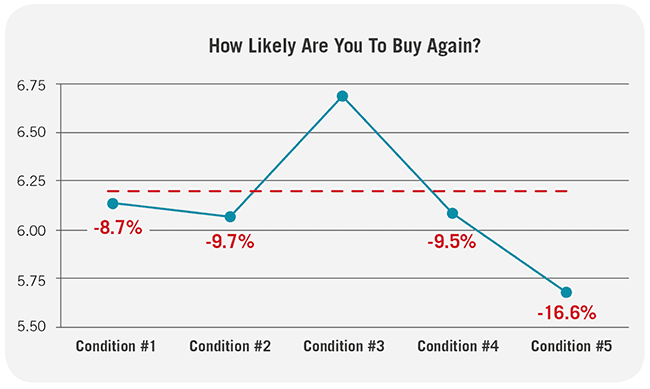
Figure 5
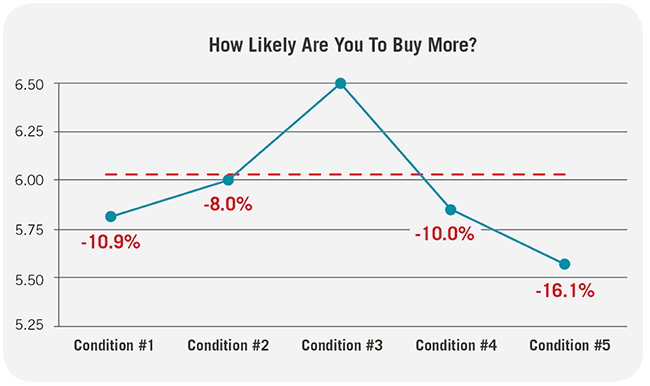
Figure 6
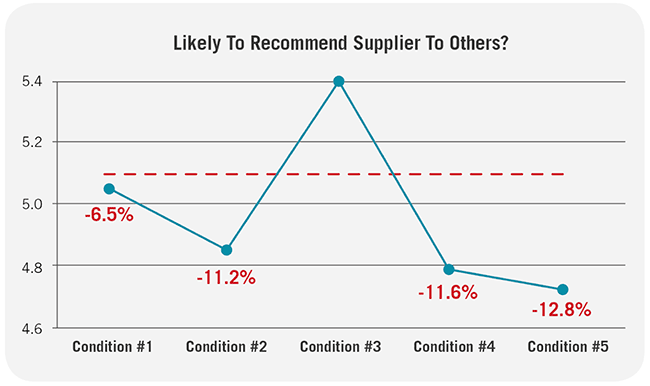
Figure 7
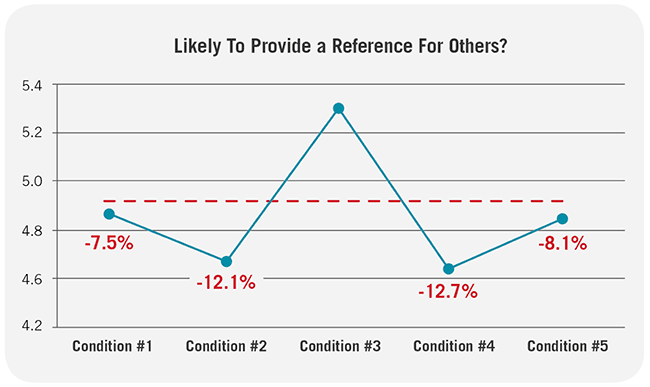
Figure 8
Another key indicator of apology success mentioned earlier is whether your customer believes you fixed the problem and that the problem will not happen again. Even in this case, you’ll see it’s the same apology message that inspires the greatest confidence in the supplier moving forward: Condition #3 (Figures 9–10). These findings eliminate all doubt as to which configuration you should apply to get the best SRP-related results. And, should cause you significant hesitation if you’re considering any other approach.
A final set of questions and results are more tied to perceptions of the message itself, considerations such as the credibility and overall effectiveness of the message. Again, you will see the same clear winner is Condition #3 (Figures 11–14).
Again, due to the inconsistencies displayed by the other messaging approaches, there is one, clear winner and no clear second choice when it comes to the perceived quality of your apology.
Winning example
Here is the winning apology messaging condition as delivered in the test:
- Offer of repair
- Acknowledgement of responsibility
- Declaration of repentance
- Explanation of problem
- Expression of regret
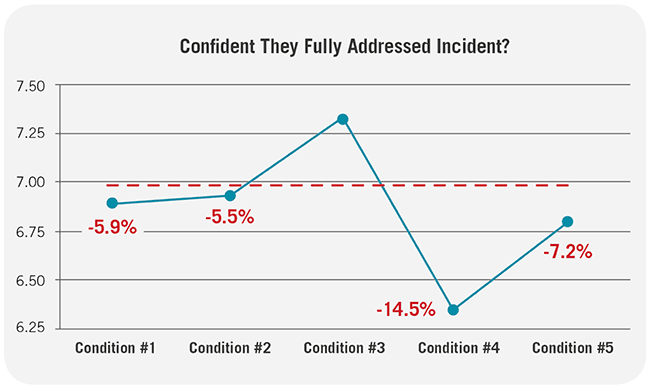
Figure 9
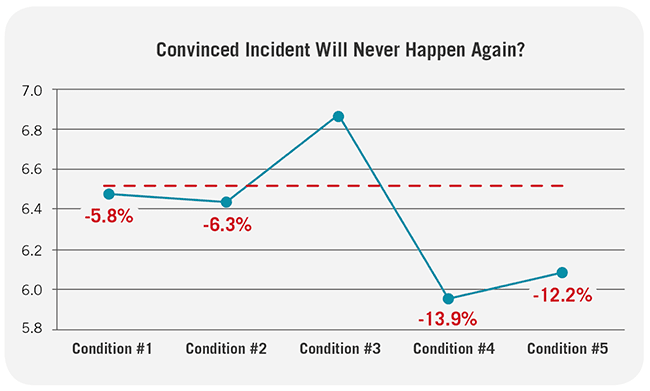
Figure 10
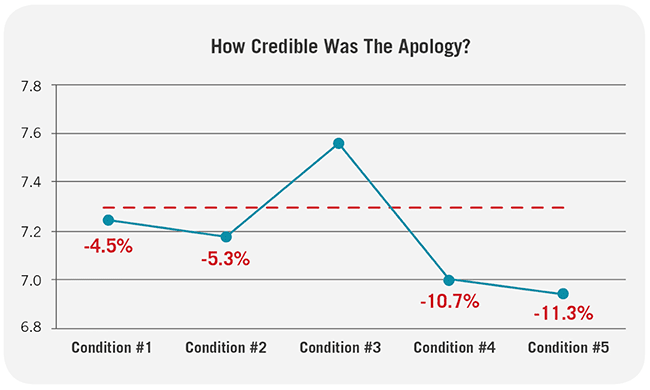
Figure 11
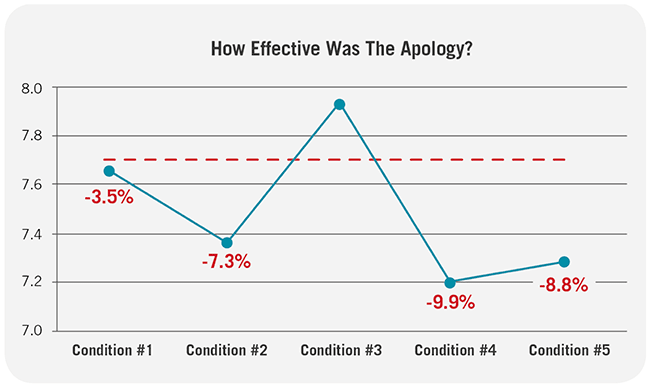
Figure 12
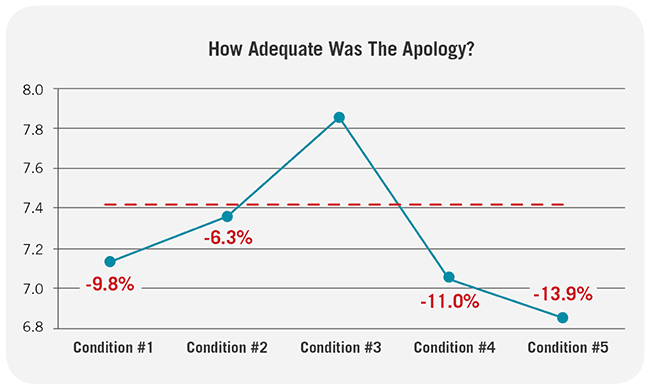
Figure 13
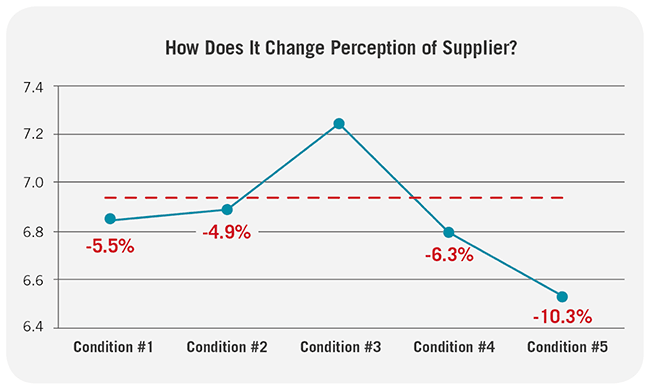
Figure 14
“I want to attempt to repair any possible problems this outage caused for you, your team, or your employees. First, I have been approved to provide your company with a one-month refund, twice the length of your benefits sign-up period. It is an expanded refund in recognition that this happened at a peak time for your company. I have also directed our customer service team to manually check all sign-ups that occurred after the software came back online to be sure they were captured accurately. I will let you know the outcome as soon as it is complete, no longer than one week from now.
“The software outage was entirely our fault. It should not have happened at all, let alone during such a critical time for your business. We take full responsibility and are committed to ensuring it will not happen again. I fully regret that this outage occurred, and our teams are making the necessary changes to make sure it does not happen again. Our outages should be reserved for planned down-time, with advance communication, and we regret that we failed on both accounts in this situation.
“To let you know what occurred, your software went down after a major power outage at one of our data centres. Your workload was re-routed to our other data centres, as part of our back-up plan and service agreement. However, the second centre your content was assigned to was down due to preventive maintenance and a hardware update. This caused your system to go down for a period as the system reconfigured to find the next alternative for your workload. We have now updated our redundancy system to avoid anything like this in the future.”
“I am exceptionally sorry for this outage, and as soon as I knew about it I was in constant communication with our technical teams until it was resolved. On behalf of our company, I would like to apologize not only to you, but your leadership team and all affected employees.”
Sidebar 2 – How important are apologies to you?
As part of the study on apologies we also conducted an industry survey to understand how important companies believe apologies are to their customer relationships, and how well they think they are doing in terms of delivering effective apologies when their customers experience the inevitable product or service failure with their solution.

Figure A
More than 78% said apologies are very important and that their customer retention rates and revenue growth absolutely depend on delivering a convincing apology. Another 18% said it was important that they respond to problem situations quickly and effectively to mitigate potential damage to the customer relationship. Companies recognize that apologies will indeed occur, with a large impact on revenue success. No one expects a completely flawless customer experience (Figure A).
Even though it is very clear that companies believe apologies are critical to their customer and business success, it was interesting to see what they had to say about their current efforts to develop and deliver effective apologies. The majority (54%) say their approach is either “ad hoc” or they “wing it” which means they leave it up to the individuals on the account to determine what they need to say and how they need to say it. Only 13% say they take a highly formalized approach, including a documented structure for their apologies, one where everyone knows exactly how to communicate with customers after a major problem (Figure B).

Figure B
That means there’s a big gap between how important companies feel apologies are to their success and how much structured effort they put into ensuring their apologies are effective. This led to a third question in our survey to find out how confident they are that their company is delivering good apologies despite lacking a formal approach.

Figure C
It turns out just 18% of companies are completely confident in the effectiveness of their apologies, which corresponds closely to the 14% that approach them with a highly formal strategy (Figure C). The rest (81%) are not completely confident in their apologies.
This survey seems to prove the industry would benefit from a tested, proven framework for consistently developing and delivering the most effective apologies.
Conclusion: make your apologies count
The inevitable customer service failure doesn’t need to be a time of panic or dismay. The service recovery paradox demonstrates it may be an opportunity to increase customer satisfaction and loyalty to levels greater than if your customer never experienced a problem with you.
But, there are better and worse ways to engage your customer to achieve this result. In this study, you can see that there is a clear and consistent apology framework you can use to build and deliver your apology message – and positively affect even your most angry and bitterly disappointed customers.
No more guesses or opinions about how to apologize. And, no more vague advice telling you to be authentic, transparent and empathetic. (How do you know for sure when you are even doing that?) Based on this research, you now have a specific, detailed, science-backed apology messaging framework for more effectively dealing with the most difficult parts of sales and customer service – apologizing for a service failure.





